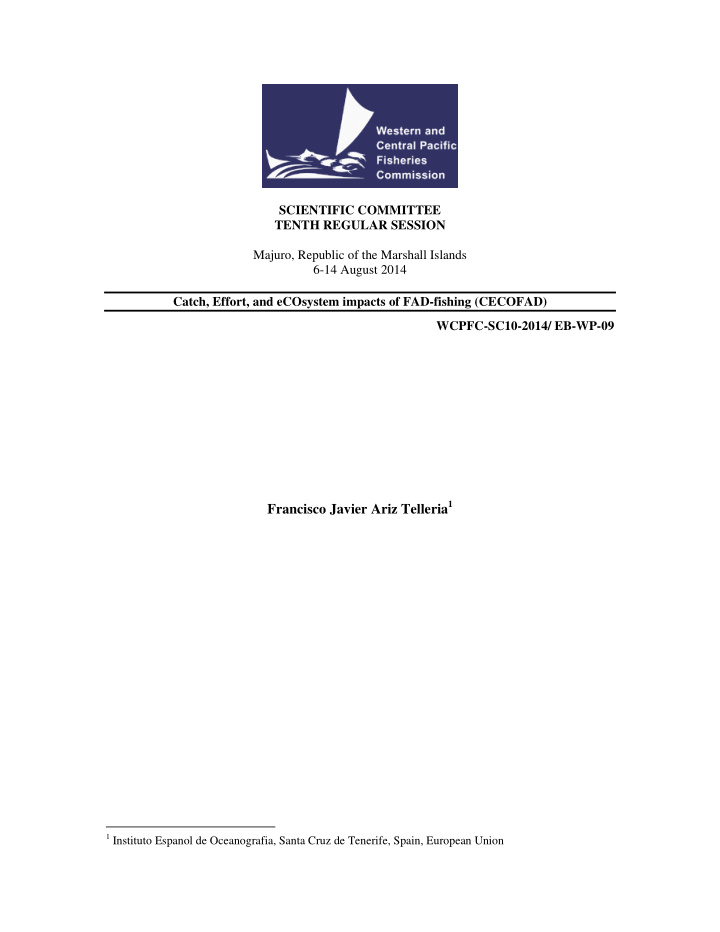



SCIENTIFIC COMMITTEE TENTH REGULAR SESSION Majuro, Republic of the Marshall Islands 6-14 August 2014 Catch, Effort, and eCOsystem impacts of FAD-fishing (CECOFAD) WCPFC-SC10-2014/ EB-WP-09 Francisco Javier Ariz Telleria 1 1 Instituto Espanol de Oceanografia, Santa Cruz de Tenerife, Spain, European Union
Catch, Effort, and eCOsystem impacts of FAD-fishing (CECOFAD) Dr Francisco Javier Ariz Telleria Instituto Espanol de Oceanografia Santa Cruz de Tenerife Spain, European Union WCPCF, 10th Scientific Committee Meeting, Majuro, Republic of the Marshall Islands, 6-14 August 2014 1
This project is funded by the European Commission under the European Common Fisheries Policy MARE/2012/24 Lot 1: Standardization of tropical tuna catch and effort time series for EU purse seine fleets using FADs in the Atlantic, Indian and Pacific Ocean and estimation of by catch and ecosystem impacts. CECOFAD Participants 2
Catch, Effort, and eCOsystem impacts of FAD-fishing (CECOFAD) Coordinating organisation: Institut de Recherche pour le développement (IRD) Name of the coordinating person : Daniel Gaertner (IRD) Steering committee: Javier Ariz (IEO), Nicolas Bez (IRD), Daniel Gaertner (IRD), Gala Moreno (AZTI), Hilario Murua (AZTI), Maria Soto (IEO) Scientific partners : Institut de Recherche pour le Développement (IRD, France), Instituto Español de Oceanografía (IEO, Spain), AZTI Tecnalia (AZTI, Spain), Professional partners : Organisation des producteurs de thon tropical congelé et surgelé (ORTHONGEL (France), Asociación Nacional de Buques Atuneros Congeladores (ANABAC, Spain), Organización de Productores Asociados de Grandes Atuneros Congeladores (OPAGAC, Spain) Observers : International Tuna Commission for the Conservation of Atlantic Tunas (ICCAT), Indian Ocean Tuna Commission (IOTC), Inter-American Tropical Tuna Commission (IATTC) and International Seafood Sustainability Foundation (ISSF). 3
Effect on fishing effort (calculation of PS fishing effort and changes in fishing grounds) Purse seine fishery is based on the visual detection of tuna schools atthe surface of the sea. Traditionally, the searching time (eg, daily hours searching for tuna schools) was used to calculate the fishing effort. The introduction of FADs equipped with transmitters changed this concept. After, FADs fishing the purse Before FADs fishing, seiner detects electronically its Free school and own FADs and may run directly natural logs were in the good direction. Free randomly detected school, logs and foreign FADs continue to be randomly searched during daily hours. 4
Challenges Free school CPUEs standardization remains problematic: - Non random distribution of fishing effort - Time and spatial autocorrelation - Increasing fishing power - Cooperation between fishers (i.e., code groups) In addition to the impact of FAD-fishing on the tuna resource, other non-target species (e.g., sharks, rays, turtles) are also affected by this fishing mode Regular requests expressed by tuna RFMOs to European tuna scientists to provide reliable estimates of abundance indices and accurate indicators on the impact of FAD-fishing on juveniles of tunas and on bycatch species 5
Structure and objectives of the project The project will be organized into 4 Work Packages (WPs), as follows: WP 1- Definition of a unit of fishing effort for purse-seiners using FADs that accounts for different factors influencing catchability ( Objective 1 of the project ), WP 2- Standardization of catch-per-unit-effort series of the EU purse seine fleet, for juveniles and adults of the three tropical tuna species and exploration of some FAD- regulations in management strategies ( Objective 2 ), WP 3- Alternatives to catch rates (WP 2 and 3 in conjunction will address ( Objective 2 ), WP 4.- Provision of information on catch composition around FADs and estimation of potential impacts on other marine organisms (e.g. by-catch of sharks and cryptic mortality; Objective 2 ). 6
Timing of work packages CECOFAD Months 1 2 3 4 5 6 7 8 9 10 11 12 13 14 15 16 17 18 Update of introduction and use of new WP1 WP1a technology Recovery of historic data for performing WP1 WP1b FADs indicators WP2 WP2b Local vs global CPUEs WP4 WP4a Impact of FADs on the spatio temporal dynamic of tunas and bycatch Recovery of echosounder WP3 WP3a information Quantification of biomass removed WP4 WP4a by FAD fishing WP3 WP3a Alternative indices collected from different sources WP3 WP3a Modeling the agregation of biomass under FAD networks WP1 WP1a Fishing activities of a supply vessel WP1 WP1b FAD-trajectories based indicators WP1 WP1a Fisher behaviour-at-sea (alone vs group) WP1 WP1c Reallocation of fishing effort by fishing modes WP4 WP4b Soaking time and FAD origin effects on catch and by catch WP1 WP1b FADs indicators based on historic data WP2 WP2a Incorporation of technology in CPUE standardization WP2 WP2b Movements of fish and fleets on the CPUEs standardization Prior elicitation of change in catchability WP1 WP1a (production model) Impact of a supply vessel on WP2 WP2a the PS CPUEs WP2 WP2c FAD catch rate indicators WP2 WP2b FAD drift modeling and spatialized regulations Ratio estimate of classical and ecological WP4 WP4b FAD used WP1 WP1c Proportion of time at sea by activity WP3 WP3a Index of FAD density and aggregated abundance 7
Sharks and turtles cryptic mortality Classic FAD No entangling FAD 8
No entangling FAD Classical Fad 9
10
Recommend
More recommend